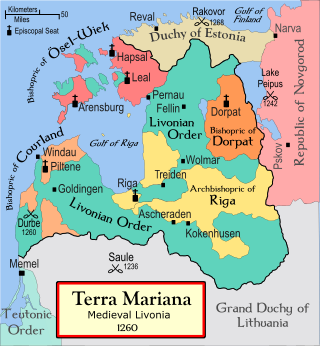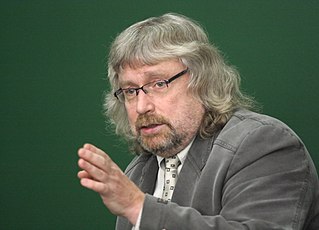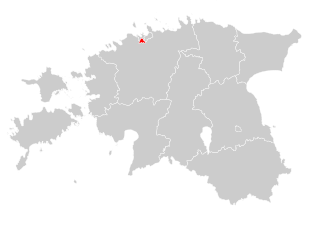
Saint George's Night Uprising in 1343–1345 was an unsuccessful attempt by the indigenous Estonian population in the Duchy of Estonia, the Bishopric of Ösel-Wiek, and the insular territories of the State of the Teutonic Order to rid themselves of Danish and German rulers and landlords who had conquered the country in the 13th century during the Livonian Crusade; and to eradicate the non-indigenous Christian religion. After initial success the revolt was ended by the invasion of the Teutonic Order. In 1346, the Duchy of Estonia was sold for 19,000 Köln marks by the King of Denmark to the Teutonic Order. The shift of sovereignty from Denmark to the State of the Teutonic Order took place on November 1, 1346.

Estonia sent 27 athletes to the 2006 Winter Olympics in Turin, Italy. Half of them competed in cross-country skiing, where Estonia won all of their three Turin Olympic medals. Olympic champion Andrus Veerpalu participated on his 5th Winter Olympics.
The Congress of Estonia was an innovative grassroots parliament established in Estonia in 1990–1992 as a part of the process of regaining of independence from the Soviet Union. It also challenged the power and authority of the pre-existing quasi-parliament in the country, called the Supreme Soviet of the Estonian SSR, which had been imposed on Estonia after the Soviet invasion, occupation and illegal annexation of Estonia in 1940. The Congress of Estonia declared that it represented the highest authority on questions of Estonian statehood and citizenship, deriving this authority from the consent and initiative of the citizens of Estonia. The aim of the Congress was to restore Estonian independence based on the principle of legal continuity, with the pre-1940 Republic of Estonia, which had been established in 1918, as the foundation.

Rodulff (Rodulf) is claimed by a 15th-century chronicle Chronicon episcoporum Finlandensium to have worked as a missionary "bishop" in Finland after Bishop Henry had died in the 1150s. Rodulff was allegedly from Västergötland in Sweden.
Sulev Vahtre was an eminent Estonian historian.

The following is an alphabetical list of articles related to the Republic of Estonia.
Tuulepealne maa is a twelve-part Estonian television mini-series about the pre-World War II history of Estonia, its birth as a country, the Estonian War of Independence, post-war life throughout 1920 up to 1941 and World War II.

Lauri Vahtre is an Estonian politician, historian, translator and writer.
The Governor was the leader of a county (maakond) in Estonia. Here is the list of governors of Estonian counties.
Vahtre is a surname. Notable people with the surname include:

Karl Säre was a Soviet and Estonian communist politician. He was the first first secretary of the Central Committee of the Estonian Communist Party. During World War II, he was arrested by Nazi Germany and taken to Sachsenhausen concentration camp, where he died in 1945. The Soviet government avoided the mention of Säre's name in any public sources, as he was suspected of treason by disclosing to Nazi Germany information about the Stalinist officials and pro-Soviet agents who had remained in German-occupied Estonia during the war.
Kersti Heinloo is an Estonian stage, film and television actress who began her career in radio.
Sulev is an Estonian masculine given name.
This article lists events that occurred during 1984 in Soviet Estonia.

Electoral district no. 3 is one of the 12 multi-member electoral districts of the Riigikogu, the national legislature of Estonia. The electoral district was established in 1995 following the re-organisation of the electoral districts in Tallinn. It is conterminous with the districts of Mustamäe and Nõmme in Tallinn. The district currently elects eight of the 101 members of the Riigikogu using the open party-list proportional representation electoral system. At the 2019 parliamentary election it had 71,882 registered electors.

Electoral district no. 12 is one of the 12 multi-member electoral districts of the Riigikogu, the national legislature of Estonia. The district was established in 1992 when the Riigikogu was re-established following Estonia's independence from the Soviet Union. It was renamed electoral district no. 11 in 1995 following the re-organisation of electoral districts but reverted to electoral district no. 12 in 2003. It is conterminous with the county of Pärnu. The district currently elects seven of the 101 members of the Riigikogu using the open party-list proportional representation electoral system. At the 2019 parliamentary election it had 66,852 registered electors.
Electoral district no. 10 was one of the multi-member electoral districts of the Riigikogu, the national legislature of Estonia. The district was established in 1992 when the Riigikogu was re-established following Estonia's independence from the Soviet Union. It was abolished in 1995. It was conterminous with the county of Tartu.
This is a list of the members of the Riigikogu, following the 1992 election.
Constitutional Assembly of Estonia was the representative body whose goal was to create new Constitution of the Republic of Estonia. The assembly was composed on 20 August 1991 by the members from Committee of Estonia and Supreme Council of the Republic of Estonia. The assembly functioned until 10 April 1992.